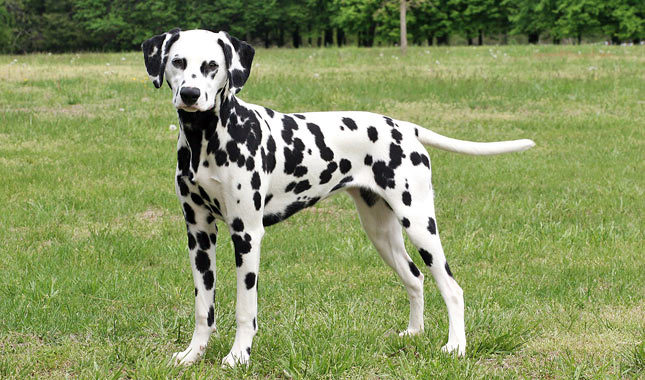Tails
Making pet parenting easy

Dalmatian
This entry was posted on 2014-07-16.
A very well known breed the Dalmatian is most prized for its white coat spotted with either brown or black markings. This is a very active breed and was historically used as carriage dogs and at a time was even bred to run with horses. This would be the ideal pet for people that will allow it plenty time for physical activity and give it a lot of attention.
Traits
• Other names: Carriage Dog, Firehouse Dog, Spotted Coach Dog, Plum Pudding Dog
• Nicknames: Dalmatiner, Dal
• Weight: Males: 15–32 kg, Females: 16–24 kg
• Height: Males: 53–66 cm, Females: 46–64 cm
• Coat: Short, fine dense hairs
• Colour: White with round spots. Spots: Brown or Black
• Litter size: About 15 puppies
• Life span: 12-14 years
Physical Characteristics
The Dalmatians coat is short and glossy; its facial expression is that of alertness and intellect. Its body, which is square-proportioned, has strong bones and an athletic build. This gives the dog endurance and a stable and unchallenging trot.
Personality and Temperament
The Dalmatian is a very frisky and enthusiastic breed. It loves to wander around and can run for a very long time until it gets tired, so because of this it should be exercised in a secure area. This breed is shy around unknown dogs and people but is very good around other pets and horses. In terms of young children the Dalmatian may be too energetic and lively.
Dalmatians also have a willing nature and are keen to please; they are therefore easy to train. You need to ensure that you give them excessive praise when they have completed a task well. Nevertheless it is as easy for this breed to learn bad habits, as it is to learn good, so take note that they are very determined and the males have a very dominant nature.
Care
The Dalmatian needs a lot of exercise, so a short leased walk just wont cut it. Rather, a run (they make great running partners) or physically strenuous games in the garden. This will keep your Dalmatian looking healthy and fit. To keep its coat looking stunning, give it a good brush and bath now and again. This breed will always be happy if you provide it with a shelter, a personal soft bed, companionship and love. It prefers to live indoors but can live outdoors in warm and mild weather conditions.
Health
The average life span of a Dalmatian is 12-14 years. The minor health problems it can suffer from are allergies, hypothyroidism, seizures and iris sphincter dysplasia. The major issues are urinary stones and deafness. It can also be susceptible to the formation of urinary calculi or canine hip dysplasia (CHD). The tests that are available to check for these issues are thyroid, hearing, hip and eye exams.
History & Background
There isn’t any actual evidence stating the exact origin of the Dalmatians coat pattern. Although throughout the centuries there have been paintings, which bear resemblance to the dog. One of these paintings from 1360 a fresco, is kept in Italy in the Spanish Chapel of Santa Maria Novella, Florence.
The ancestors of the Dalmatian are thought to have been the Spotted Great Dane and the Pointer. The name of this breed was derived from Dalmatia, which is a southern region in Croatia, even though it didn’t originate there. The Dalmatian has been used to help humans in many ways over the years. It has been a war dog, a retriever, a shepherd, a sentinel, a ratter, a draft dog, a circus dog, a trailer, and a bird dog.
The invention of the car weakened the Dalmatians status in the community. Nevertheless it continued to work for fire engines as a coach dog and became known as the “fire-dog”. In 1988 the first Dalmatian was officially listed with the American Kennel Club. In 1905 the Dalmatian Club of America was founded.
Nutrition
Click here to see what breed specific pet food we sell now.


